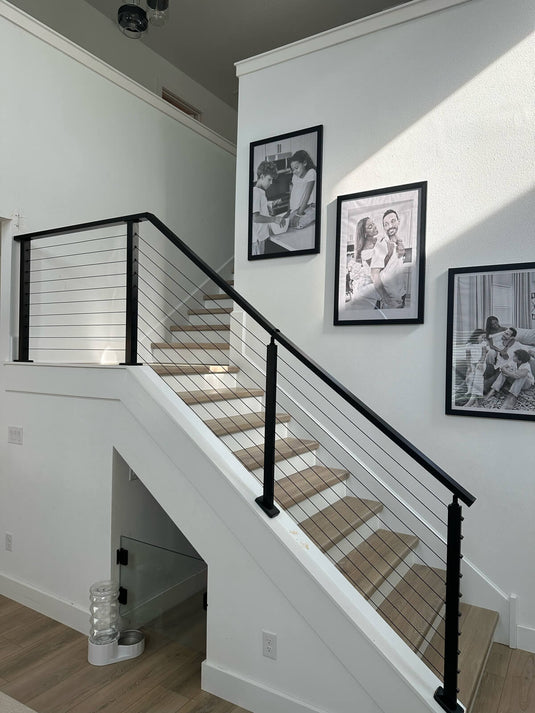TABLE OF CONTENTS
Stainless Steel Cable Railings: Pros and Cons for Residential Projects
A stainless steel cable railing is a type of cable railing where the main components, such as posts, handrails, cables, and tensioners, are all made of stainless steel. Compared to other materials, stainless steel cable railings offer superior durability, making them especially suitable for coastal and humid environments. Combining corrosion resistance with aesthetic appeal, stainless steel cable railings are a highly favored choice among cable railing systems.
Stainless steel cable railings are widely used in residential projects, including staircases, balconies, decks, yard fences, corridors, and platforms. Their open design maximizes natural views and light, seamlessly combining functionality with aesthetic appeal.
Stainless steel materials can undergo various processing techniques, resulting in diverse performance and aesthetic effects, making them suitable for different applications. If you're interested in stainless steel cable railings, we recommend reading this article to gain a deeper understanding and choose the stainless steel cable railing system that best suits your needs.

Pros of Stainless Steel Cable Railings
Corrosion resistance
Stainless steel offers excellent corrosion resistance because its surface is covered by a dense chromium oxide film (Cr₂O₃). This protective oxide layer effectively isolates corrosive substances, preventing rust. Moreover, this film has self-healing properties, allowing it to quickly regenerate if damaged, thereby continuing to protect the stainless steel. Common types of stainless steel include T304 and T316.
- T304 stainless steel: This is the most commonly used type of stainless steel, containing 18% chromium and 8% nickel, which provides good corrosion resistance. It can withstand general corrosion sources like air and moisture, but its resistance decreases in environments with saltwater or high concentrations of chlorides (such as coastal areas or near swimming pools). Therefore, T304 stainless steel is better suited for typical indoor and outdoor applications.
- T316 stainless steel: Compared to T304, T316 contains 2-3% molybdenum, which enhances its resistance to chloride corrosion. This makes T316 particularly suitable for coastal or humid environments, making it the best choice for harsh conditions such as marine climates.
Security
Stainless steel is a high-strength material with a tensile strength typically ranging from 515 to 1035 MPa, allowing it to withstand significant tensile forces without breaking. This property ensures the stability and safety of stainless steel cable railing systems, making them ideal for residential and other applications that require durability and reliability.
Aesthetics
Stainless steel cable railings typically feature a simple, clean-lined design without unnecessary decoration, creating a sleek and minimalist appearance. The stainless steel material has excellent gloss, enhancing the overall brightness of the space. At the same time, the use of cable wires instead of traditional vertical posts maximizes the preservation of views and light, maintaining an open and airy feel in the space.
Low Maintenance
Compared to other metals or materials, stainless steel cable railings are highly durable. Even after prolonged exposure, they can maintain a stable appearance and functionality, reducing the need for frequent replacements or maintenance. Additionally, maintaining stainless steel cables is simple, requiring only regular checks of the cable tension and occasional cleaning with water or mild soapy water.
Environmental protection
The environmental friendliness of stainless steel cable railing systems is reflected in several aspects. First, stainless steel is highly recyclable, helping to reduce negative environmental impacts. Second, the simple design of stainless steel cables further minimizes material usage. Lastly, the durability of stainless steel cable railing systems reduces the need for frequent replacements and maintenance, thereby lowering resource consumption and waste generation.
Cons of Stainless Steel Cable Railings
Higher cost
Compared to cable railing systems made of wood or aluminum, stainless steel cable railing systems are more expensive, primarily due to the high cost of stainless steel itself. For example, the production of stainless steel cable railings involves complex processes such as precision cutting and polishing, and their main components and accessories are all made of stainless steel, further increasing the cost. However, due to stainless steel's excellent performance and long-lasting durability, despite the higher initial investment, stainless steel cable railing systems remain a cost-effective choice in the long term, considering their extended lifespan and low maintenance requirements.
Style limitations
The stainless steel cable railing system is most suited for modern-style home designs, as its clean and sleek lines complement spaces with a strong contemporary feel. However, in traditional or vintage-style designs, stainless steel cable railings may appear too cold and lack harmony with the overall aesthetic. That said, surface treatments such as brushing or coating can soften and enrich the appearance of stainless steel, allowing it to better adapt to different design styles.
Common Surface Treatment Processes for Stainless Steel Materials
Brushed Finish
The brushed finish process on stainless steel refers to creating a uniform texture on the surface of the material through mechanical polishing or grinding, which alters its appearance and texture, similar to a matte effect.
Stainless steel materials with a brushed finish are more user-friendly in daily cleaning and maintenance. The unique linear texture design helps conceal scratches, fingerprints, and stains, making the surface appear cleaner. However, since the brushing process may damage the stainless steel's passivation layer and reduce its corrosion resistance, this treatment is not suitable for highly corrosive environments (such as coastal areas).
| Muzata posts | Muzata handrail |
 |
 |
Electrostatic Powder Coating
The electrostatic powder coating process involves using static electricity to evenly apply powder coating to the metal surface, followed by heating and curing. Stainless steel treated with this process typically has a smoother and more polished appearance.
Stainless steel materials treated with electrostatic powder coating are slightly less maintenance-friendly than those treated with a brushed finish, as their smooth surface tends to show scratches, fingerprints, and stains more easily, requiring regular cleaning and maintenance. However, the powder coating process adds a thicker layer, significantly enhancing the stainless steel's corrosion resistance and wear resistance, improving its long-term durability and protective performance. Suitable for use in seaside and humid environments.
| Muzata posts | Muzata handrail |
 |
 |
Recommended Usage Scenarios
based on the characteristics of stainless steel materials and their surface treatment processes, you can choose the appropriate Muzata stainless steel cable railing system based on the environment of your project. Here are some purchase recommendations for different environments:
Coastal Residence
Coastal residences are often exposed to humid conditions and salt mist, making corrosion resistance a key consideration when selecting materials. Muzata's electrostatic powder-coated stainless steel cable railing system perfectly meets this need. If your project is located in a similar environment, it is recommended to choose Muzata's electrostatic powder-coated handrails and posts, combined with coated steel cables and 316 stainless steel tensioners. This solution not only enhances durability but also maximizes cost-effectiveness while ensuring long-term performance.

Mountain Residences
Mountain residences are often exposed to high humidity and significant temperature variations, making durability and corrosion resistance key considerations when selecting materials. Muzata's electrostatic powder-coated stainless steel cable railing system is ideal for such environments. If your project is located in a similar mountain setting, both Muzata's electrostatic powder-coated stainless steel cable railing and the brushed stainless steel version are viable options. Although brushed cable railings have slightly lower corrosion resistance compared to the powder-coated version, they still offer sufficient durability and stability for mountain environments, making them well-suited for this type of setting.

Cold Regions
Cold regions often experience extreme low temperatures and significant temperature fluctuations, making durability and corrosion resistance critical factors when selecting materials. Muzata's electrostatic powder-coated stainless steel cable railing system is particularly suited for such environments, as snow accumulation can cause the railings to remain damp for extended periods. If your project is located in a similar cold climate, it is recommended to use Muzata's powder-coated black series railings outdoors. For indoor use, either brushed or powder-coated black options would be ideal.

from tag-elf_haus
Urban apartments
Urban apartments typically experience more stable environmental and climatic conditions. Therefore, if your project is located in a similar environment, you can freely choose the style of stainless steel cable railing based on your personal preferences.

Conclusion

Stainless steel cable railings offer numerous significant advantages in residential projects, including a modern appearance, exceptional durability, and low maintenance costs. While the initial investment may be higher, its long-lasting durability and low maintenance requirements can lead to significant cost savings in the long run. For residential projects that prioritize aesthetics, functionality, and long-term durability, stainless steel cable railings are undoubtedly an ideal choice.
Now, Muzata offers free design services for your railing projects. Simply provide basic information such as project dimensions, and we will recommend the most suitable cable railing system tailored to your needs, helping you achieve your ideal home design!
———>>>>>Start my project




